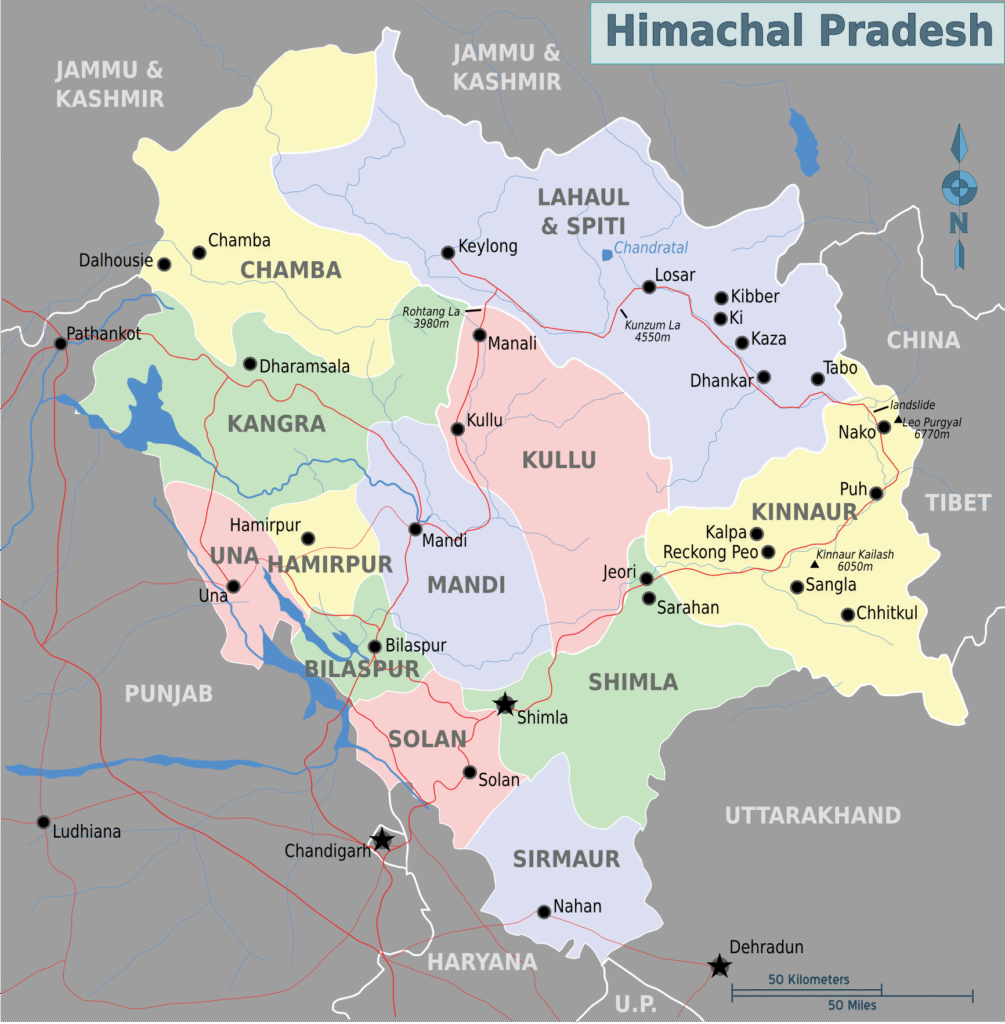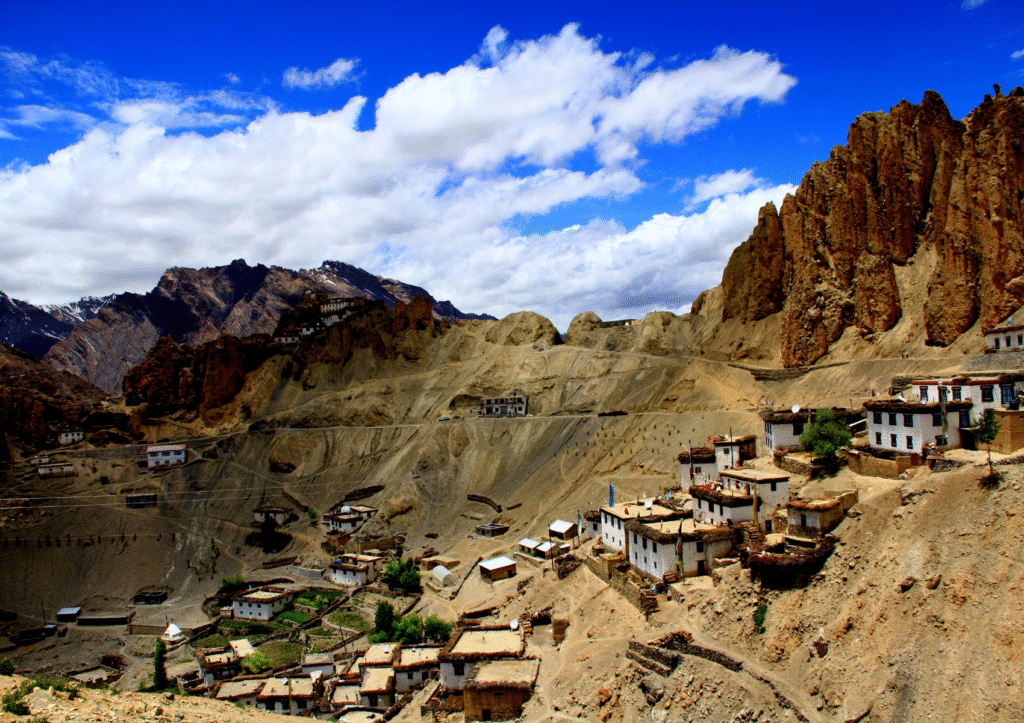Himachal Pradesh
- Location : India
- Altitude / Elevation : ?
- Popular Activities : ?
- Accommodation Options : ?
- Local Transport Options : Jeep, Train, Hired Car
- Languages Spoken : Hindi
- Tour Locations : Shimla, Kangra, Kullu, Kinnaur, Lahaul and Spiti
Himachal Pradesh
Himachal Pradesh is a predominantly mountainous state located in the Western Himalayas (the name literally translates to “snow-laden province”. Himachal spreads out across valleys with perennial rivers flowing through them. The landscape is characterised by extreme variation in weather and altitude, with more elevation, cold, alpine, and glacial landscapes in the northern and eastern mountain ranges. This has also influenced the diversity of the state’s local cultures.

Shimla District
Shimla, the capital of Himachal Pradesh, is situated within the eponymous Shimla district. Historically, Shimla was the summer capital of the British Raj and remains one of the major urban centres in Himachal. Consequently, the state’s British-era architecture continues to attract many tourists. This charming capital is also home to many ancient temples, adventure sports, apple orchards, and lesser-known trails far from the madding crowd.
When to Go:
The high season in Shimla is between March and May, after which the rainy season begins and continues until September. The winter months are quieter (except for December) and offer a more immersive experience for travellers looking to do something different.
How to Reach:
Shimla is easily accessible from Chandigarh (~4 hours), Amritsar (~6 hours), and New Delhi (~7 hours).
Shimla is accessible via direct flights from Amritsar and New Delhi.
There is a train from Delhi to Kalka, after which one can catch the Kalka-Shimla “toy train”, a UNESCO heritage narrow-gauge railway.
Kangra District
Kangra is known for having a rich history and attracts scholars and pilgrims alike. The district is home to the Kangra Fort and the ancient temples of Masrur and Baijnath. Kangra is better known by its administrative capital, Dharamsala, home to the Tibetan Government-in-exile. Someone looking to experience Tibetan culture can visit Norbulingka Institute or the Tibetan settlement of Bir, which is also a popular paragliding destination (in fact, the Paragliding World Cup took place in Bir in 2024.)
Garli village is a heritage village that is worth an overnight stay. You can also try your hand at pottery in Andretta village, an artist commune and home to one of the oldest pottery studios in India.
When to Go:
The high season in Kangra is between March and May (with temperatures going up to 36 Celsius), after which the rainy season begins and continues until mid-September. It is strongly advised not to visit Kangra during the monsoon – it is the wettest district in the state. The autumn and winter months are milder.
How to Reach:
Kangra is easily accessible from Chandigarh (~5 hours), Amritsar (~4 hours), and New Delhi (~9 hours).
Gaggal Airport, near Dharamsala, is accessible via direct flights from New Delhi and Chandigarh.
The nearest major train station is Pathankot, located approximately 85 km from Dharamsala. One can then take a taxi or a bus to Dharamsala or take a narrow-gauge train to Jogindernagar, near Andretta and Bir.
Kullu District
Arguably one of Himachal’s most popular districts, Kullu-Manali (as it is known to locals) is beloved by both hippies and honeymooners alike. Manali was the starting point of an ancient trade route which crossed the Rohtang and Baralacha passes to Kashmir, passing through the cold deserts of Lahaul and Ladakh. Today, it is the gateway to the Lahaul and Spiti district as well as Ladakh.
Naggar, an ancient town located an hour from Manali, was once the seat of the Kullu dynasty. Here, one can visit the Naggar castle, a standard of the vernacular architecture of the region known as “kath kuni” and the Roerich Gallery, once home to Russian painter Nicholas Roerich, to whom the Himalayas were both muse and final resting place. The Great Himalayan National Park (GHNP) is also located within Kullu. Bird watchers can visit to sight rare species of migratory birds and those indigenous to the region. GHNP is also popular for many very special trekking routes.
When to Go:
The high season in Manali is between March and May. The monsoon begins in mid-June and continues until mid-September. Manali sees a lot of snow in the winter, and most trekking routes in Kullu are inaccessible. Still, other valleys are relatively pleasant with splendid vistas on offer.
How to Reach:
Kinnaur District
Ringed by the Himalayan, Zangskar, and Dhauladar regions, Kinnaur lies along the ancient trade route between India and Tibet. The region has only recently been made more easily accessible via road and is a lesser-known destination for tourists. The culture is a harmonious syncretism of both Hindu and Buddhist beliefs. Mount Kinner Kailash is located here. Kinnaur is also home to many beautiful villages such as Nako and Chitkul, the last village on the Indo-Tibetan border.
When to Go:
Summer in Kinnaur is between June and September, while the winter lasts from October to May. Some valleys in the state fall under a rain shadow area, which means they can be visited during the monsoon season.
How to Reach:
Kinnaur is easily accessible by road from any major towns within Himachal Pradesh. Shimla is a convenient start point for most travellers looking to visit Kinnaur and then proceed onward to Lahaul and Spiti.

Lahaul and Spiti District
Lahaul and Spiti is a cold desert region notable for its striking landscapes and harsh climate. Many adventure and thrill-seekers visit Lahaul and Spiti for the challenging treks in the valley; however, it is also easily accessible by car for those wishing to visit the valley through a jeep safari.
The Lahaul and Spiti district was once ruled under the kingdom of Ladakh. Several ancient monasteries (gompas), some over a 1000 years old, dot the landscape and are important centers of learning and home to many rare scriptures. Kye gompa, Tabo gompa, and Dhankhar gompa are a few popular ones.
Lahaul and Spiti are known for their rich fossil deposits, particularly marine fossils dating back to the Tethys sea era. The region is also home to many unique flora and fauna that have adapted to the harsh climactic conditions. Snow leopards, ibex, musk deer, Tibetan antelopes, and the Himalayan brown bear inhabit this region.
When to Go:
The best time to visit Lahaul and Spiti is between May and September.
How to Reach:
Lahaul and Spiti are accessible by road from Manali.

We’re an ethical eco-travel agency led by industry veterans, offering tailored Trans-Himalayan journeys.
Further Links
Get In Touch
- 163/1, Palm Meadows, Ramagondanahalli, Whitefield, Bengaluru 560066
- +91 98450 28448
- support@treksntrails.in